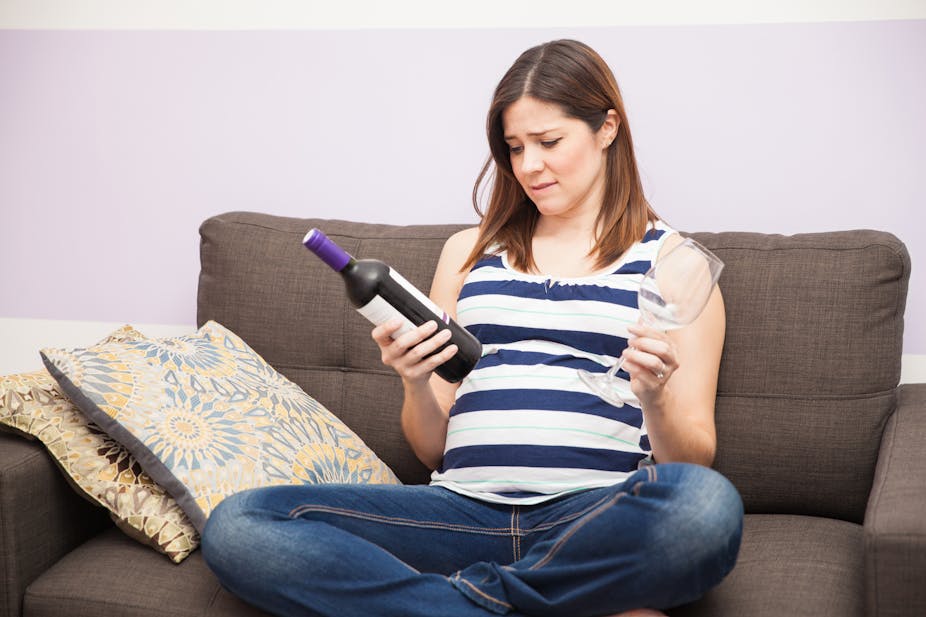How much do you know about the guidance on drinking in pregnancy? Most are aware of the “don’t drink” message. But if you’re an expectant mother, or someone who’s job involves giving advice, our new study shows that the abstinence message can feel too simplistic.
The UK’s Chief Medical Officers recommend that women completely stop from drinking when planning a baby or when pregnant. Their guidance is based on an evidence review which found that heavy drinking while pregnant increases the risk of stillbirth, miscarriage and low-birth weight. It is also associated with foetal alcohol syndrome and foetal alcohol spectrum disorders – conditions that affect physical and mental development.
The review found little evidence of harm from drinking at low levels of around one to two units a week (one unit of alcohol works out at as just over half a small glass of 13% wine, or just under half a pint of 4% beer). However, there were few high quality studies relating to drinking at low levels.
Putting this evidence together, the Chief Medical Officers issued a simple “don’t drink” message. Their decision was based on a “precautionary principle” (“better safe than sorry”), because absence of evidence does not equal absence of effect, and because the review had been unable to find a “safe” cut-off point.
Keep it simple?
For our recently published research, we looked at how this “better safe than sorry” message is being communicated to women, taking account of the experience of mothers, midwives, antenatal teachers and policy makers.

Some of the midwives we spoke were comfortable with a blanket “don’t drink” message because it is in line with a clear approach taken to communicating all kinds of lifestyle advice to expectant mothers, such as “don’t smoke” and “avoid seafood”. Midwives also find there isn’t time to go into much detail.
On the other hand, some of the women we talked to said they would prefer more nuanced information so that they can come to their own decisions. And some professionals felt that simplifying the evidence for drinking at low levels undermined the credibility of the guidance overall.
Pregnancy (un)planning and social drinking
Our research also suggests that guidance to abstain from alcohol when trying for a baby is often incompatible with many women’s experiences of pregnancy planning. Not all pregnancies are fully planned, and drinking before realising is extremely common. Survey data indicates that drinking in pregnancy is “socially pervasive” in UK, with around three-quarters of women consuming some alcohol. Around a third of women report binge drinking (defined as six or more units per drinking occasion), with most of it occurring in the first trimester of pregnancy.
Many of our participants agreed that the guidance did not fully engage with the needs and anxieties of women who have drunk alcohol early on. But some midwives we spoke to were worried about giving women false reassurance by saying that drinking alcohol would probably have done no harm.

Social drinking is deeply embedded in UK culture, and most women enjoy a drink from time to time. Drinking is so “normal” that some women find that by not drinking they are disclosing a pregnancy before they want to. Not drinking can mean social loss, made worse when friends and partners continue to drink around the pregnant woman. Even when women abstain but still socialise, some experience being urged to have a drink when they’ve said they don’t want to.
When women do decide to have a drink, we found that they risk being shamed. Several participants had had comments from complete strangers – though many saw this as just another part of the wider cultural understanding that it’s okay to comment on what a pregnant woman should and should not do. When it comes to the guidance, both mothers and professionals were concerned that the blanket “don’t drink” message might be making this shaming worse.
Communicating the facts

Evidently, the way that women are given alcohol guidance during pregnancy is not helping them as best it could. Based on our conversations, we think women would benefit from having more information about why a precautionary approach is being recommended. The guidance could be boosted by enabling women to explore the topic to a depth that meets their own information needs.
As there is no single type of pregnancy, we also believe that midwives, antenatal teachers and mothers may be better served by a strategy that addresses different types of pregnancy planning. The guidance does indicate that women who have drunk alcohol before realising should try not to worry, but more work is needed to improve the way this message is delivered.
In addition, given that social drinking is so prevalent, there is the potential to think about the role of partners, family and friends in affirming and supporting expectant mothers in their decisions. For example, by choosing not to drink when she doesn’t.

